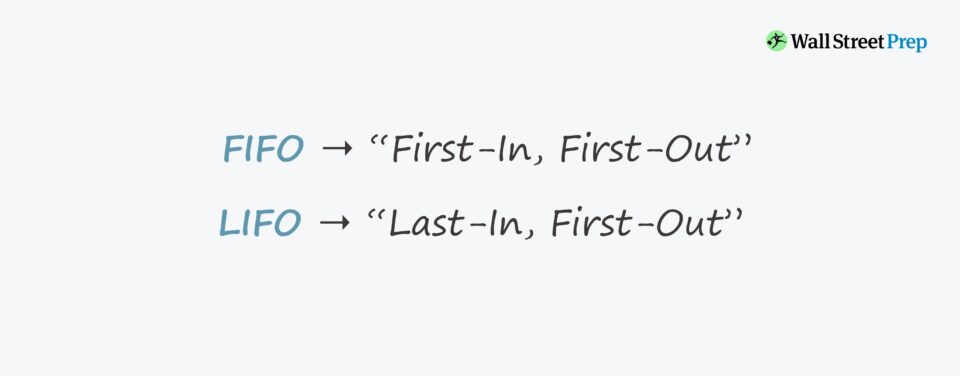What is FIFO vs. LIFO?
FIFO and LIFO are two methods of accounting for inventory purchases, or more specifically, for estimating the value of inventory sold in a given period.

FIFO vs. LIFO Accounting: What is the Difference?
FIFO and LIFO are the two most common inventory valuation methods used by public companies, per U.S. GAAP reporting standards.
So, what is the difference between FIFO and LIFO?
FIFO is an abbreviation for “First In, First Out.”
- Under the FIFO approach of accounting, the inventory purchased earlier is the first to be recognized and expensed on the income statement, within the cost of goods sold (COGS) line item.
- Outside of the U.S., only FIFO is permitted under IFRS, so FIFO tends to be the prevalent inventory valuation method for international companies.
In contrast, LIFO stands for “Last In, First Out.”
- LIFO, unlike FIFO, recognizes the more recently purchased inventories ahead of those purchased earlier – i.e. the most recent inventory purchases are the first to be sold.
- Under U.S. GAAP accounting standards, the LIFO inventory valuation method is permitted, causing the FIFO vs. LIFO decision to be a discretionary decision for publicly-traded companies.
- Hence, many U.S. companies will present their financial statements in accordance with the LIFO method on their filings and financial statements with the SEC, but switch to FIFO for their international operations (e.g. subsidiaries).
FIFO vs. LIFO: What are the Pros and Cons?
The FIFO vs. LIFO accounting decision matters because of the fact that inventory cost recognition directly impacts a company’s current period cost of goods sold (COGS) and net income.
Considering the net income – the accounting measure of profitability (the “bottom line”) on the income statement – is the numerator in the calculation of a company’s earnings per share (EPS) figure, the reported EPS each period is affected too.
The formula to calculate the earnings per share (EPS) metric, on a fully diluted basis, is as follows.
| Change in Inventory Costs | Inventory Valuation Method | Impact on COGS | Impact on Net Income |
|---|---|---|---|
|
|
|
|
|
|
|
|
|
|
|
|
|
|
|
|
How Does LIFO and FIFO Impact Net Income?
To further expand upon the summary chart, the LIFO vs. FIFO rules under rising inventory costs are as follows:
- Rising Inventory Costs ➝ Lower COGS Recorded under FIFO (and Higher Net Income)
- Rising Inventory Costs ➝ Higher COGS Recorded under LIFO (and Lower Net Income)
For example, suppose a hypothetical scenario, where the inventory purchased earlier is less expensive compared to recent purchases.
Since the inventory purchased first was recognized, the company’s net income (and earnings per share, or “EPS”) will each be higher in the current period – all else being equal.
With that said, if inventory costs have increased, the COGS for the current period are higher under LIFO.
By contrast, suppose inventory costs were to decline – the impacts of FIFO vs LIFO are as follows:
- Declining Inventory Costs ➝ Higher COGS Under FIFO (and Lower Net Income)
- Declining Inventory Costs ➝ Lower COGS Under LIFO (and Higher Net Income)
By contrast, the inventory purchased in more recent periods is cheaper than those purchased earlier (i.e. older inventory costs are more expensive).
Therefore, considering the older, more expensive inventory was recognized, net income is lower under FIFO for the given period.
Conversely, COGS would be lower under LIFO – i.e. the cheaper inventory costs were recognized – leading to higher net income.
FIFO vs. LIFO Calculation Example
Suppose a clothing retailer sold 100 units of t-shirts in 2023, at the following pricing rates:
- Current Inventory Cost per Unit = $20.00
- Past Inventory Cost per Unit = $10.00
The percentage difference in the inventory cost per unit – a 100% increase (i.e. 2.0x) – shows how the retailer’s more recent spending on inventory purchases has increased compared to prior purchases.
- % Change in Inventory Cost per Unit = ($20.00 ÷ $10.00) – 1 = 100.00%
Under the two inventory valuation methods, FIFO and LIFO, the following could be recognized as COGS in our simple exercise intended for illustrative purposes:
- FIFO → $10.00 × 100 Units = $1,000
- LIFO → $20.00 × 100 Units = $2,000
Since inventory costs have risen in recent periods, LIFO causes the retailer’s COGS to increase and net income to decrease on its income statement for the current period – whereas COGS would be lower under FIFO, and the reported net income would be higher.

Everything You Need To Master Financial Modeling
Enroll in The Premium Package: Learn Financial Statement Modeling, DCF, M&A, LBO and Comps. The same training program used at top investment banks.
Enroll Today





